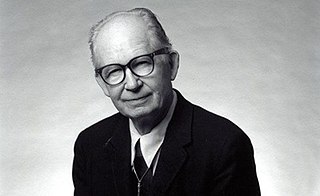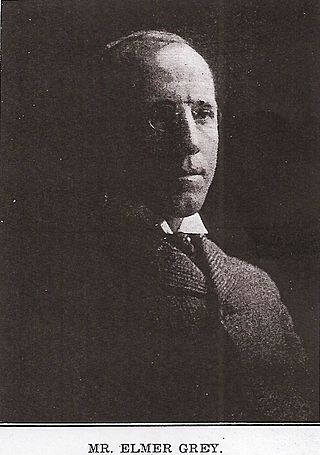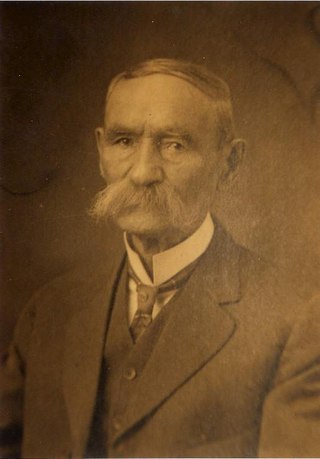Related Research Articles

Frank Lloyd Wright Sr. was an American architect, designer, writer, and educator. He designed more than 1,000 structures over a creative period of 70 years. Wright played a key role in the architectural movements of the twentieth century, influencing architects worldwide through his works and mentoring hundreds of apprentices in his Taliesin Fellowship. Wright believed in designing in harmony with humanity and the environment, a philosophy he called organic architecture. This philosophy was exemplified in Fallingwater (1935), which has been called "the best all-time work of American architecture".

Racine is a city in and the county seat of Racine County, Wisconsin, United States. It is located on the shore of Lake Michigan at the mouth of the Root River, situated 22 miles (35 km) south of Milwaukee and 60 miles (97 km) north of Chicago. As of the 2020 census, the city had a population of 77,816, making it the fifth-most populous city in Wisconsin. It is the principal city of the Racine metropolitan statistical area. The Racine metropolitan area is, in turn, counted as part of the greater Milwaukee combined statistical area.

Usonia is a term that was used by the American architect Frank Lloyd Wright to refer to the United States in general, and more specifically to his vision for the landscape of the country, including the planning of cities and the architecture of buildings. Wright proposed the use of the adjective Usonian to describe the particular New World character of the American landscape as distinct and free of previous architectural conventions.

John Russell Pope was an American architect whose firm is widely known for designing major public buildings, including the National Archives and Records Administration building, the Jefferson Memorial and the West Building of the National Gallery of Art, all in Washington, D.C.

John Lloyd Wright was an American architect and toy inventor. Born in Oak Park, Illinois, Wright was the second-oldest son of famed architect Frank Lloyd Wright. John Lloyd Wright became estranged from his father in 1909 and subsequently left his home to join his brother on the West Coast. After unsuccessfully working a series of jobs, he decided to take up the profession of his father in 1912. Shortly afterward, he was able to reconnect with his father, who took John under his wing. Differences in opinion regarding the Imperial Hotel, Tokyo caused the pair to again become disunited.

C. W. & George L. Rapp, commonly known as Rapp & Rapp, was an American architectural firm famed for the design of movie palaces and other theatres. Active from 1906 to 1965 and based in Chicago, the office designed over 400 theatres, including the Chicago Theatre (1921), Bismarck Hotel and Theatre (1926) and Oriental Theater (1926) in Chicago, the Five Flags Center (1910) in Dubuque, Iowa and the Paramount Theatres in New York City (1926) and Aurora, Illinois (1931).

Taliesin is a house-studio complex located 2.5 miles (4.0 km) south of the village of Spring Green, Wisconsin, United States. Developed and occupied by American architect Frank Lloyd Wright, the 600-acre (240 ha) estate is an exemplar of the Prairie School of architecture. Wright began developing the estate in 1911 on land that previously belonged to his maternal family.

Prairie School is a late 19th and early 20th-century architectural style, most common in the Midwestern United States. The style is usually marked by horizontal lines, flat or hipped roofs with broad overhanging eaves, windows grouped in horizontal bands, integration with the landscape, solid construction, craftsmanship, and discipline in the use of ornament. Horizontal lines were thought to evoke and relate to the wide, flat, treeless expanses of America's native prairie landscape.

Mid-century modern (MCM) is a movement in interior design, product design, graphic design, architecture and urban development that was present in all the world, but more popular in North America, Brazil and Europe from roughly 1945 to 1970 during the United States's post-World War II period.

Racine College was an Episcopal preparatory school and college in Racine, Wisconsin, that operated between 1852 and 1933. Located south of the city along Lake Michigan, the campus has been maintained and is today known as the DeKoven Center, a conference center, educational facility, and special events venue operated by the DeKoven Foundation.

Elmer Grey, FAIA was an American architect and artist based in Pasadena, California. Grey designed many noted landmarks in Southern California, including the Beverly Hills Hotel, the Huntington Art Gallery, the Pasadena Playhouse and Wattles Mansion. He is credited with being one of the pioneers in the development of the new American architecture in the early 20th century, with a focus on harmony with nature and eliminating features not belonging to the local climate and conditions. Grey was also a noted artist whose paintings are in the permanent collection of the Chicago Art Institute.

The Charles L. and Dorothy Manson home is a single-family house located at 1224 Highland Park Boulevard in Wausau, Wisconsin. Designated a National Historic Landmark, it was listed on the National Register of Historic Places on April 5, 2016, reference Number, 16000149.

Henry C. Koch was a German-American architect based in Milwaukee, Wisconsin.
The 2008 McDonald's All-American Boys Game was an All-star basketball game played on Wednesday, March 26, 2008 at the Bradley Center in Milwaukee, Wisconsin, home of the NBA's Milwaukee Bucks. The game's rosters featured the best and most highly recruited high school boys graduating in 2008. The game was the 31st annual version of the McDonald's All-American Game first played in 1978.
Johnsen Schmaling Architects is an architecture firm located in Milwaukee, Wisconsin, United States, where it was founded in 2003 by Brian Johnsen and Sebastian Schmaling. The office is located in a former shoe factory in the Brady Street district of Milwaukee. The principals have described their design philosophy as "poetic realism". Johnsen and Schmaling are on the faculty of the School of Architecture & Urban Planning at the University of Wisconsin–Milwaukee.
A. Arthur Guilbert was an architect in Racine, Wisconsin.

Lucas Bradley (1809–1889) was an American architect in Racine, Wisconsin. He designed the Eli R. Cooley House in Racine, Wisconsin, the John Collins House, George Murray House and Racine College.

David Richard Jones was a Welsh-American architect and poet.
Sam Himmelfarb was a Russian Empire-born, American artist and commercial exhibit designer, known for his modernist-influenced paintings of everyday people and urban scenes. He also designed the Frank Lloyd Wright-inspired Samuel and Eleanor Himmelfarb Home and Studio in Winfield, Illinois, which is listed on the National Register of Historic Places. Himmelfarb studied art at the Art Students League and National Academy of Design in New York and at the Wisconsin School of Fine and Applied Arts. He initially painted in a realist style influenced by the Ashcan School, which gave way to more modernist, increasingly abstract styles. His paintings appeared in exhibitions at the Art Institute of Chicago (AIC), Terra Museum of American Art, Milwaukee Art Institute, and Arts Club of Chicago, and in circulating shows from the American Federation of Arts, among other venues. He received awards from the AIC, Wisconsin State Fair and Milwaukee Art Museum, and his work belongs to the collection of the latter, and those of the Illinois State Museum, Block Museum, and Arkansas Art Center, among others. Himmelfarb was married to the artist and educator, Eleanor Himmelfarb (1910-2009); their son, John Himmelfarb, and grandchild, Serena Aurora Day Himmelfarb, are also artists.

Alfred Clas was an architect in Milwaukee, Wisconsin. He was a partner in the firm Ferry & Clas with George Bowman Ferry and in 1913 Alfred C. Clas partnered with his son Reuben F. Clas and with John S. Shepherd, as junior partners, to form the firm of Clas, Shepherd & Clas. Shepherd withdrew in 1931 and the firm became Clas & Clas, Inc., with Alfred Clas remaining president until his death in 1942.
References
- ↑ Brief obituary Archived 2008-05-16 at the Wayback Machine